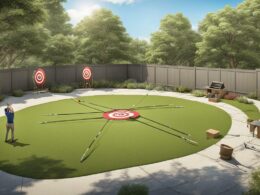When it comes to maintaining your landscaping, one important task to consider is bush trimming. This not only helps keep your bushes and shrubs looking neat and well-maintained, but it also promotes their healthy growth. However, before embarking on any landscaping project, it’s crucial to have a clear understanding of the bush trimming cost factors that may impact your budget.
In the United States, the average cost for bush trimming ranges from $50 to $75 per hour or $6 to $15 per bush. These figures can vary depending on several factors that affect the overall cost. It’s essential to consider these factors to effectively plan and budget for your landscaping needs.
Factors that influence the cost of bush trimming include the type of bush, its condition, the time of year, the level of detail required, the location of the bush, and the cost of debris removal. Different types of bushes may require different trimming techniques, affecting the time and effort involved. The condition of the bush, such as overgrowth or dead leaves, can also impact the cost as it may require additional work.
The time of year can also affect the cost, with higher demand during the spring and summer months potentially resulting in higher prices. Additionally, the level of detail required for the trimming job, the location of the bush (whether it’s easily accessible or in a more challenging spot), and the need for debris removal can all contribute to the overall costs.
By understanding these cost factors, you can effectively plan your budget and make informed decisions about your landscaping needs. Whether you’re looking to hire a professional landscaper or considering a DIY approach, evaluating the costs and weighing the benefits is crucial in achieving a well-maintained landscape while staying within your budget.
Average Costs of Bush Trimming
When it comes to maintaining the beauty and health of your bushes, understanding the average costs of bush trimming is essential. The national average cost for bush trimming is $60 per hour. However, the actual cost can vary depending on various factors.
For small bushes under 2 feet tall, the average cost is around $35. These smaller bushes usually require less time and effort to trim. On the other hand, larger bushes over 2 feet tall may cost around $60 to trim. The increased size of these bushes often necessitates more extensive trimming.
It’s important to note that some landscapers may offer a flat rate for trimming a certain number of bushes. This can be beneficial if you have multiple bushes that require trimming, as it provides a more predictable cost.
By understanding the average costs associated with bush trimming, you can better budget for the maintenance of your landscape. Whether you have small or large bushes, knowing what to expect in terms of costs allows you to plan accordingly and ensure your bushes receive the care they need.
Factors That Affect Bush Trimming Cost
When it comes to bush trimming, several factors come into play that can influence the overall cost. It’s important to take these factors into consideration when budgeting for your landscaping needs. By understanding the various elements that affect the cost, you can make informed decisions and ensure that your bushes are well-maintained without breaking the bank.
One of the key factors that affect the cost of bush trimming is the type of bush. Certain bushes may require more time and effort to trim compared to others, resulting in higher costs. For example, bush species with intricate growth patterns or dense foliage can be more labor-intensive to trim, contributing to increased costs.
The condition of the bush is another factor to consider. Overgrown bushes or those with dead leaves and branches may require additional work and time for trimming. This additional effort can impact the overall cost, as more time and resources are needed to restore the bush to its desired shape and health.
The time of year also plays a role in bush trimming costs. During peak seasons, such as spring and summer, landscaping services are in high demand, leading to increased prices. It’s important to factor in the timing of your bush trimming project to ensure you’re prepared for any potential price fluctuations.
The level of detail you require for your bushes is another consideration. If you desire intricate designs or precise shaping, it may require more time and expertise from the landscaper, leading to higher costs. On the other hand, if you simply need a general trimming, the cost may be lower.
The location of the bush can also affect the cost. Accessibility issues, such as bushes located in hard-to-reach areas or on uneven terrain, may require additional effort, equipment, or precautions, resulting in increased costs.
Additionally, the removal of debris resulting from bush trimming should be considered. Some landscapers may include debris removal as part of their service, while others may charge an extra fee. Make sure to clarify the debris removal process with your landscaper to avoid any surprises when it comes to billing.
Related Services
In addition to bush trimming, professional landscapers provide a range of related services to ensure that your outdoor space is well-maintained and visually appealing. These services include:
- Hedge trimming, which involves shaping and sculpting hedges to promote healthy growth and create a neat appearance.
- Tree trimming, which focuses on removing dead or overgrown branches to enhance the tree’s health and aesthetic appeal.
- Tree removal, which is necessary when a tree is diseased, damaged, or poses a safety risk.
- Shrub removal, which involves the removal of unwanted or unsightly shrubs from your landscape.
- Mulching, which helps to retain moisture in the soil, suppress weed growth, and improve the overall health of your plants.
- Lawn mowing, which ensures that your grass is kept at an appropriate height for a manicured appearance and healthy growth.
- Yard cleaning, which involves clearing debris, such as leaves and branches, to maintain a clean and tidy outdoor space.
These services can be tailored to meet your specific needs and can either be scheduled as recurring maintenance or provided on an as-needed basis. The cost of these services varies depending on the specific task and the size of your property, and can add to the overall cost of your landscaping maintenance.
DIY Bush Trimming and Cost Comparison
While hiring a professional landscaper for bush trimming may seem convenient, it is possible to trim your own bushes and save money.
The cost of DIY bush trimming includes the one-time cost of equipment, such as safety glasses, work gloves, pruning shears, a gas pole pruner (optional), a shovel, and a tarp. The DIY cost of equipment is approximately $285, while hiring a professional can range from $50 to $75 per hour.
Consider the time and effort required for the DIY approach before deciding which option is right for you.
- Ensure that you have the appropriate safety gear, including safety glasses and work gloves, to protect yourself during the trimming process.
- Invest in quality pruning shears and consider purchasing a gas pole pruner for reaching taller bushes.
- Use a shovel to clear the area around the bushes and spread a tarp to collect the trimmed branches and leaves.
- Follow proper techniques for trimming your bushes to ensure their health and appearance.
- Keep in mind that DIY bush trimming requires time and effort on your part, so evaluate whether you have the availability and dedication to complete the task effectively.
By comparing the cost of hiring a professional to the cost of DIY bush trimming, you can make an informed decision that aligns with your budget and landscaping goals.
How Can Power Lines in My Backyard Impact Bush Trimming Costs?
When it comes to bush trimming costs, the presence of moving backyard power lines can greatly impact the overall expenses. Trimming around power lines requires special equipment and trained professionals, which can significantly increase the cost of maintenance. It’s important to be mindful of these potential expenses when planning for backyard landscaping.
Conclusion
Understanding the factors that influence bush trimming cost is essential for effectively budgeting for your landscape maintenance needs. When it comes to bush trimming, several factors come into play that can impact the overall cost.
The type and condition of the bush are significant factors. Some bushes may require more time and effort to trim, resulting in a higher cost. Additionally, the time of year can affect the cost, as the demand for bush trimming services tends to be higher during the spring and summer seasons.
The level of detail you require and the location of the bush can also impact the overall cost. If you need intricate trimming or have bushes that are challenging to access, the cost may be higher. Additionally, related services such as hedge trimming or tree removal may add to the overall cost.
By evaluating these factors and comparing the cost of hiring a professional to the cost of DIY bush trimming, you can make an informed decision and ensure your bushes are well-maintained while staying within your budget. Consider the time, effort, and equipment required for DIY trimming before deciding which option is right for you.










